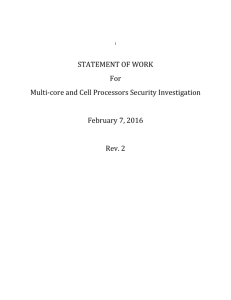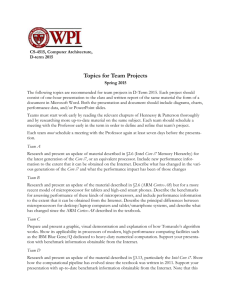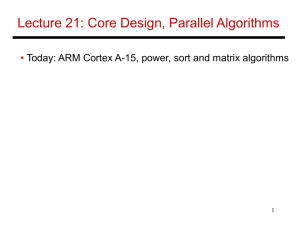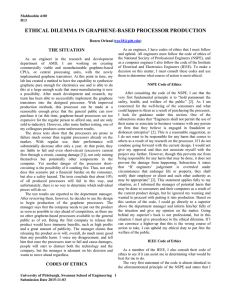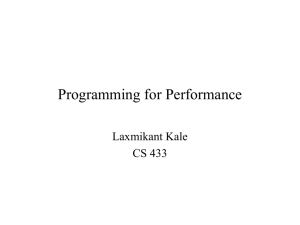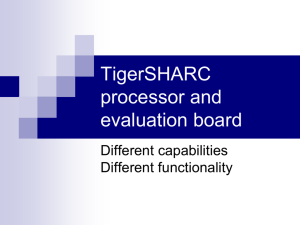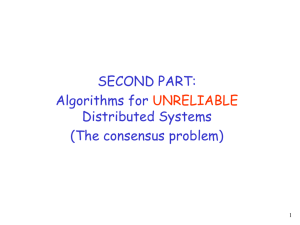Syllabus - Peter H. Anderson
advertisement
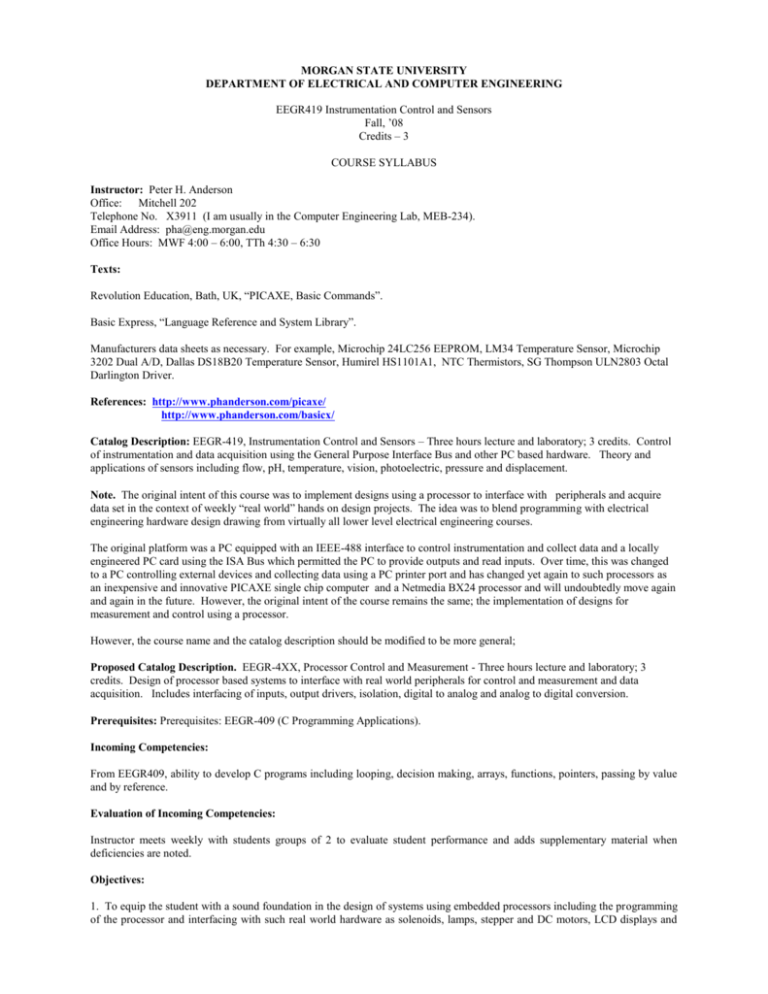
MORGAN STATE UNIVERSITY DEPARTMENT OF ELECTRICAL AND COMPUTER ENGINEERING EEGR419 Instrumentation Control and Sensors Fall, ’08 Credits – 3 COURSE SYLLABUS Instructor: Peter H. Anderson Office: Mitchell 202 Telephone No. X3911 (I am usually in the Computer Engineering Lab, MEB-234). Email Address: pha@eng.morgan.edu Office Hours: MWF 4:00 – 6:00, TTh 4:30 – 6:30 Texts: Revolution Education, Bath, UK, “PICAXE, Basic Commands”. Basic Express, “Language Reference and System Library”. Manufacturers data sheets as necessary. For example, Microchip 24LC256 EEPROM, LM34 Temperature Sensor, Microchip 3202 Dual A/D, Dallas DS18B20 Temperature Sensor, Humirel HS1101A1, NTC Thermistors, SG Thompson ULN2803 Octal Darlington Driver. References: http://www.phanderson.com/picaxe/ http://www.phanderson.com/basicx/ Catalog Description: EEGR-419, Instrumentation Control and Sensors – Three hours lecture and laboratory; 3 credits. Control of instrumentation and data acquisition using the General Purpose Interface Bus and other PC based hardware. Theory and applications of sensors including flow, pH, temperature, vision, photoelectric, pressure and displacement. Note. The original intent of this course was to implement designs using a processor to interface with peripherals and acquire data set in the context of weekly “real world” hands on design projects. The idea was to blend programming with electrical engineering hardware design drawing from virtually all lower level electrical engineering courses. The original platform was a PC equipped with an IEEE-488 interface to control instrumentation and collect data and a locally engineered PC card using the ISA Bus which permitted the PC to provide outputs and read inputs. Over time, this was changed to a PC controlling external devices and collecting data using a PC printer port and has changed yet again to such processors as an inexpensive and innovative PICAXE single chip computer and a Netmedia BX24 processor and will undoubtedly move again and again in the future. However, the original intent of the course remains the same; the implementation of designs for measurement and control using a processor. However, the course name and the catalog description should be modified to be more general; Proposed Catalog Description. EEGR-4XX, Processor Control and Measurement - Three hours lecture and laboratory; 3 credits. Design of processor based systems to interface with real world peripherals for control and measurement and data acquisition. Includes interfacing of inputs, output drivers, isolation, digital to analog and analog to digital conversion. Prerequisites: Prerequisites: EEGR-409 (C Programming Applications). Incoming Competencies: From EEGR409, ability to develop C programs including looping, decision making, arrays, functions, pointers, passing by value and by reference. Evaluation of Incoming Competencies: Instructor meets weekly with students groups of 2 to evaluate student performance and adds supplementary material when deficiencies are noted. Objectives: 1. To equip the student with a sound foundation in the design of systems using embedded processors including the programming of the processor and interfacing with such real world hardware as solenoids, lamps, stepper and DC motors, LCD displays and input switches. 2. To introduce such concepts as an R-2R ladder, digital to analog and analog to digital conversion, logging of data for later access, and interfacing with external devices using a Philips I2C protocol, the Motorola SPI protocol and the Dallas Semiconductor 1-wire interface.. 3. To develop student skills in carefully documenting their circuits with functional schematics and circuit descriptions and programs with thorough program descriptions, annotations and giving variables and functions meaningful names. 4. To develop student skills in developing and implementing both software and hardware debugging strategies. 5. To equip the student with the necessary tools that they may develop embedded processor designs for industrial use. 6. To enhance meaningful summer employment opportunities and entry level competitiveness. Content. 1. Binary Coding. Binary, Octal, Hexadecimal Representations, Binary Coded Decimal, Parity, ASCII, Gray Code, One's and Two's Compliment, Signed and Unsigned Arithmetic. 2. Combinatorial Logic Functions. NOT, AND, OR, Exclusive-Or, NAND, NOR and Compare and shift functions. 3. General Processor Architecture. Central Processor Unit, Memory (RAM, ROM, Flash EEPROM, I/O Ports. 4. Programming techniques including bit manipulation, structures, passing by value and by reference. 5. Driver circuits including transistors, Darlington arrays and FETs. 6. Use of pulse width modulation to control the speed of a DC motor. 7. Control of a stepper. 8. Use of an R-2R ladder to implement a D/A converter and successive approximation A/D. 9. Interfacing with serial devices such as an external EEPROM, A/D and Dallas 1-W temperature using the Dallas 1-W, the Philips I2C and the Motorola SPI protocol. 10. Temperature measurement using a NTC thermistor. 11. Interfacing with a Sony Infrared Remote Control. 12. Techniques for minimizing noise including segregating power runs, avoiding ground loops and the use of opto-isolators. 13. Interrupts and the use of a watch-dog timer. Format: Lecture: 3 hours per week Computer: Students are expected to spend a minimum or nine hours per week developing and debugging programs. This may either be performed in the student’s home or in the Computer Engineering Lab. Grading: Ten projects involving hand-on laboratory design assigned nearly weekly. Students must meet with the faulty member on a weekly basis to review their performance. 100 percent Expected Course Outcomes and Relationship to Program Outcomes. Students will be able to write programs in a primitive BASIC (PICAXE) and Visual Basic for single board or single chip processors. [b, design .. and interpret data, c, design a process, e, solve engineering problems]. Students will be able to design interfaces between processors and the external world including solenoids, lamps, motors, input switches, D/A, A/D, EEPROMs, temperature sensors for real time control and measurement and data logging,. [b, c, e]. Students will be able to develop both hardware and software debugging strategies in realizing working programs. [b, c, e]. The ability to realize designs using high level embedded processors [b, c, e]. Ability to prepare a clear program descriptions, use meaningful function and variable names, write clear code and provide meaningful annotations in documenting their programs and clear functional schematics [g, communication]. Relationship to Program Objectives. Nuturing environment (obj 2). Open ended .. hands on .. internships (obj 4). Documentation (obj 5) Encourage faculty to develop (obj 7) Assessment Methods: 1. Observation in weekly interviews with the instructor. 2. Student feedback. Design Content: 50 percent or 1-1/2 credits




